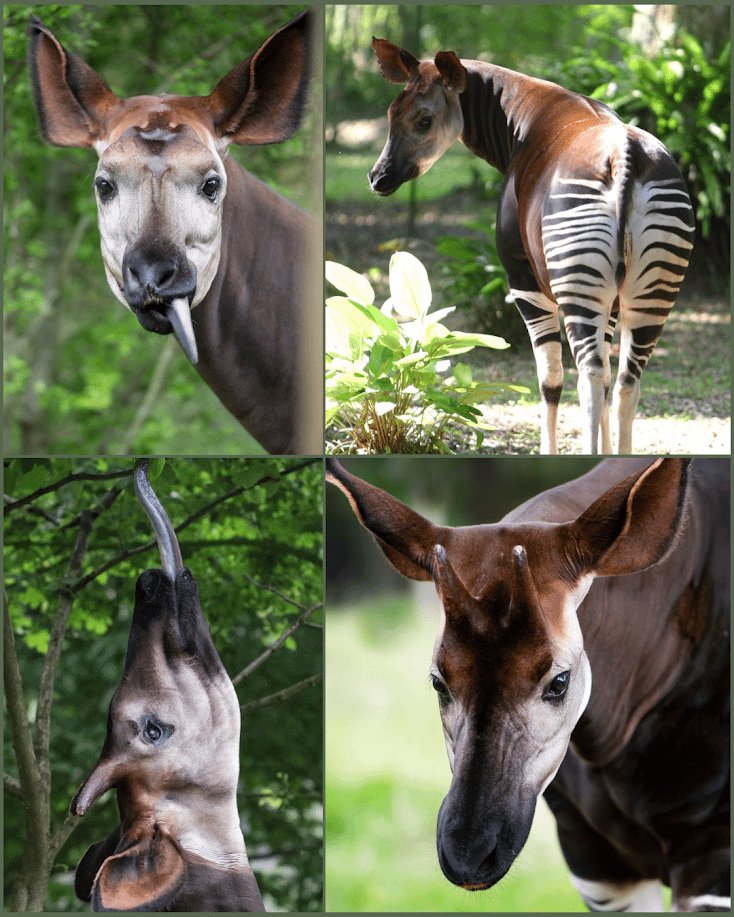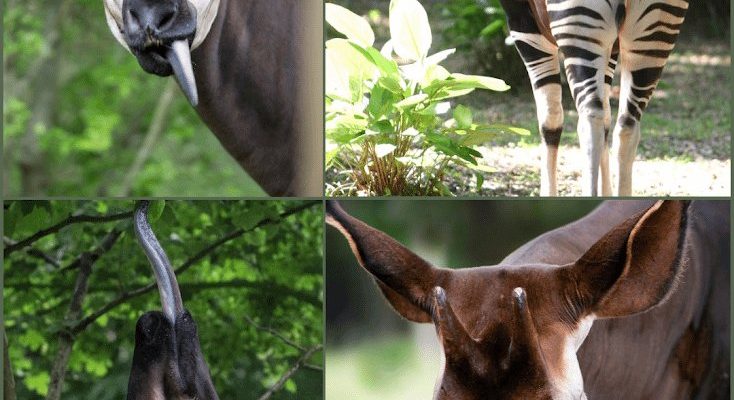
But here’s the twist: there are several other animals that share similar traits with the okapi, whether it’s their habitat, physical features, or even their behaviors. Picture this: if the okapi is the elegant dancer at a woodland gala, these other animals are a mix of quirky guests, each with their own charm. So, let’s dive into a world of fascinating creatures that resemble the okapi in various ways and explore how to tell them apart.
1. Giraffe
When you think of the okapi, the giraffe is the first cousin that comes to mind. Both animals belong to the same family, Giraffidae. While the giraffe is famous for its towering height and long neck, the okapi stands at about 5 feet tall. Here’s the thing: both have similar body shapes, but the giraffe’s neck is like a stretched spaghetti noodle compared to the okapi’s more proportionate build.
Key Differences:
- Height: Giraffes can reach up to 18 feet, while okapis max out around 5 to 6 feet.
- Neck Length: Giraffes are known for their long necks, while okapis have a more compact neck.
- Habitat: Giraffes thrive in open savannas, whereas okapis prefer dense forests.
If you spot a tall creature munching on leaves from the treetops, you can bet it’s a giraffe. But if you see a more compact animal hiding among the underbrush, it’s likely an okapi.
2. Zebra
Zebras are another neighbor in the animal kingdom that shares some similarities with the okapi. Both have striking patterns on their bodies that help them blend into their surroundings. While the okapi displays a darker, more muted pattern, zebras are decked out in bright black and white stripes. It’s like comparing a classic film to a colorful cartoon; both are enjoyable in their own right!
Key Differences:
- Coloration: Okapis have rich brown coats with white stripes on their legs, while zebras flaunt bold stripes.
- Social Behavior: Zebras are social animals that live in herds, while okapis tend to be solitary.
- Habitat: Zebras roam open grasslands, while okapis thrive in dense forests.
So, if you come across a striped animal galloping in a herd, you can confidently say it’s a zebra. But if you encounter one hiding among the trees, take a moment to appreciate the elusive okapi.
3. Tapir
Tapirs might not be the first animals that come to mind when you think of the okapi, but they share several characteristics. These large, herbivorous mammals have similar body shapes and often inhabit dense forests. Their noses resemble a small trunk, which they use for foraging, much like how okapis use their long tongues.
Key Differences:
- Body Shape: Tapirs have a more rounded body structure compared to the slender okapi.
- Facial Features: Tapirs have a distinctive snout, while okapis have a more conventional head shape.
- Habitat Range: Tapirs are found in Central and South America, while okapis are exclusive to Africa.
If you see an animal that looks like a gentle giant with a peculiar snout, it might just be a tapir. Keep an eye out for those distinctive features!
4. Antelope
Antelopes come in various shapes and sizes, and some species bear a strong resemblance to the okapi. For instance, the bongo, with its reddish-brown coat and white stripes, can remind you of the okapi’s unique coloring. Both animals are herbivores and thrive in similar habitats, typically dense forests.
Key Differences:
- Horns: Most antelope species, including bongos, have horns, while okapis do not.
- Body Size: Antelopes can be quite varied in size, with some being larger than okapis.
- Social Structure: Many antelopes are social and live in groups, whereas okapis are mostly solitary.
If you’re wandering through African jungles and spot a shy, striped creature munching on leaves but notice horns, it’s likely an antelope.
5. Okapi’s Cousins: Giraffids
Not to get too technical, but let’s talk about the broader family of giraffids. While the okapi and giraffe are the main players, there were once more species in this family. These long-necked creatures remind us of ancient times when different members roamed the earth. While we don’t have modern relatives for all of them, understanding the family tree helps us appreciate the okapi’s uniqueness.
Key Differences:
- Extinct Species: Giraffids once included species like the Sivatherium, which were much larger.
- Neck Length and Shape: The extinct relatives had varied neck lengths compared to today’s giraffe and okapi.
- Adaptations: Each species adapted to their environment, leading to differences in behavior and diet.
Even though most giraffids have bid farewell to the earth, their legacy lives on through the okapi and giraffe.
6. Indian Elephant
At first glance, it might seem odd to compare the okapi with the Indian elephant, but hear me out. Both animals inhabit lush forests, and they share a gentle nature. The Indian elephant is smaller than its African cousin, just as the okapi is smaller than the giraffe. They both play essential roles in their ecosystems, helping to keep their environments healthy.
Key Differences:
- Size: Indian elephants are massive compared to okapis, which can be easily overlooked.
- Physical Features: Elephants have large ears and trunks, unlike the okapi’s more delicate features.
- Social Structure: Elephants are highly social creatures, while okapis prefer solitude.
If you ever encounter a gentle giant with large ears, you’ll know it’s an Indian elephant, not an okapi!
7. Bongo
As mentioned earlier, the bongo is a striking antelope that can be easily confused with the okapi at first glance. With its reddish-brown fur and white stripes, the bongo has a similar aesthetic. Both animals use their unique colors to blend into the forest, making them skilled at hiding from predators.
Key Differences:
- Body Shape: Bongos are stockier and shorter than okapis.
- Habitat Preferences: While both prefer dense forests, bongos are often found in more open spaces as well.
- Social Behavior: Bongos are social and often found in groups, unlike the solitary okapi.
So if you spot a reddish creature with curves and horns, chances are you’re looking at a bongo!
8. Kudu
Similar to the bongo, the kudu is another antelope that shares some visual traits with the okapi. They have long legs and remarkable markings, which, like the okapi’s stripes, help them blend into their environment. Kudus bring a certain elegance to the savanna.
Key Differences:
- Horns: Male kudus have long, spiral horns, which are a telltale sign.
- Habitat: Kudus are more adapted to savanna and scrub areas compared to the okapi’s dense forests.
- Social Structure: Kudus are also more sociable, often found in herds.
If you catch a glimpse of an animal with those impressive spiraled horns and elegant stature, you’ve identified a kudu!
9. Red River Hog
These bush-pig relatives are not exactly similar to the okapi at first glance, but they do share a common habitat in African forests. The red river hog’s unique coloration and clumsy disposition make it an adorable counterpart to the okapi’s elegance.
Key Differences:
- Body Type: Red river hogs are stocky and have a more robust build.
- Snout and Ears: Their snouts are more pig-like and larger compared to the okapi’s delicate face.
- Behavior: They are social animals often seen in groups, unlike the solitary okapi.
If you spot a furry creature rooting around in the underbrush with a grunting sound, you’ve probably found a red river hog!
10. Duiker
Duikers are small antelopes that might catch your eye when you’re on the lookout for an okapi. They’re similar in size and also have slender legs, but their body shapes and colors differ quite a bit. Duikers are quick and agile, darting through the forest underbrush with ease.
Key Differences:
- Body Size: Duikers are much smaller than okapis and are generally more nimble.
- Coloration: They have a more uniform color compared to the striking patterns of an okapi.
- Habitat Usage: Duikers can thrive in a variety of habitats, whereas okapis stick to the forest.
If you see a smaller creature zipping around the forest floor, it might just be a duiker!
In a world filled with diversity, the okapi finds a unique place among its relatives. From the towering giraffe to the elusive duiker, these animals all tell a story of adaptation and survival. Next time you think of the okapi, remember the fascinating family it has and how each creature brings its own charm to the animal kingdom.

